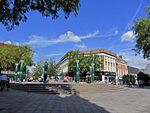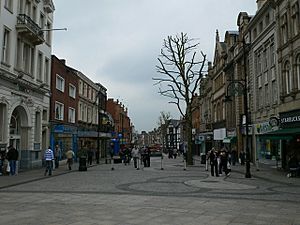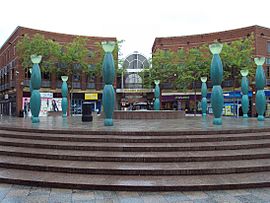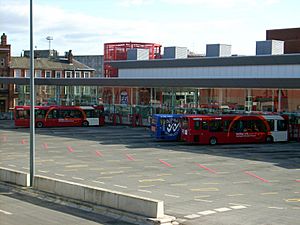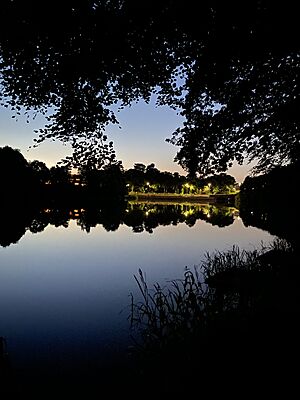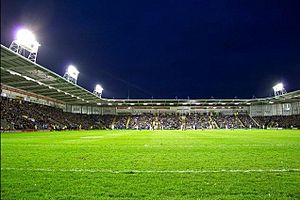Warrington facts for kids
Quick facts for kids Warrington |
|
|---|---|
| Town | |
|
The town hall, Transporter Bridge, parish church, Skittles on Market Gate square, Crown Street and Bridge Street |
|
| Area | 44.89 km2 (17.33 sq mi) |
| Population | 174,970 |
| Unitary authority |
|
| Ceremonial county | |
| Region | |
| Country | England |
| Sovereign state | United Kingdom |
| Post town | Warrington |
| Postcode district | WA1–WA5 |
| Dialling code | 01925 |
| EU Parliament | North West England |
| UK Parliament |
|
Warrington (/ˈwɒrɪŋtən/) is a busy town in Cheshire, England. It sits by the River Mersey and was once part of Lancashire. Warrington is about 16 miles (26 km) east of Liverpool and 16 miles (26 km) west of Manchester.
In 2021, about 174,970 people lived in the main town area. The wider area, called the borough, had a population of 210,900. This is more than double its size in 1968, when it became a "new town." As of December 2024, Warrington's population was around 211,200. It is the biggest town in the county of Cheshire.
Warrington was first started by the Romans. They built it at an important place where people could cross the River Mersey. Later, a new settlement was created by the Saxon people called Wærings. By the Middle Ages, Warrington became a market town because it was the lowest point where a bridge could be built over the river. People in Warrington have been making textiles (cloth) and tools for a very long time.
The town grew a lot during the Industrial Revolution. This was especially true after the Mersey River was made easier for boats to travel on in the 1700s. Major railway lines, like the West Coast Main Line, run through the town. The Manchester Ship Canal also goes through the south of the area. Big motorways like the M6, M56, and M62 motorway surround the town, making it easy to get to.
The modern area of Warrington was formed in 1974. It combined the old town with parts of several nearby districts.
Contents
- What's in a Name?
- A Look Back in Time
- How Warrington is Governed
- Warrington's Location and Landscape
- People of Warrington
- Warrington's Economy
- Getting Around Warrington
- Culture and Fun
- Education in Warrington
- Sports in Warrington
- News and Media
- Famous People from Warrington
- Warrington's Twin Towns
- Freedom of the Borough
- See also
What's in a Name?
The name "Warrington" first appeared as "Weringtun" before the Norman Conquest. In 1086, it was called "Wallintun" in the Domesday Book. The name likely comes from an old English word, waru, which means "those who care for or guard." The ending "ton" comes from tun, meaning "fenced area" or "enclosure." So, Warrington might mean "the fenced area of the guardians."
A Look Back in Time
Early Days
Warrington has always been a key place to cross the River Mersey. There was a Roman settlement here called Wilderspool. Old discoveries show that people also lived here during the Bronze Age. In medieval times, Warrington was important as a market town and a place to cross the river. The first mention of a bridge in Warrington was in 1285. The town center grew around St Elphin's Church. Warrington was also the first town in Lancashire to have paved streets, which happened in 1321.
The English Civil War
Warrington played a big part in the English Civil War. Both Oliver Cromwell's army and the Earl of Derby's army stayed near the old town center. There's a story that Cromwell stayed near a building on Church Street. On August 13, 1651, Warrington was where the Royalists won their last battle of the war. Scottish troops fought against Parliamentarians at the Battle of Warrington Bridge.
Industrial Growth
Warrington grew a lot during the Industrial Revolution. This happened especially after the Mersey River was made easier for boats to use in the 1700s. As Britain became industrial, Warrington became a town that made things. It was known for steel (especially wire), textiles, brewing, tanning, and chemicals. The river and new canals helped the town become richer. When steam power arrived, Warrington used it for transport and for its factories.
World War II and After
During World War II, Warrington was home to the Burtonwood RAF base and the Risley Ordnance Factory. RAF Burtonwood was the biggest US Army Air Force base outside the United States. Famous American stars like Humphrey Bogart and Bob Hope visited to entertain the soldiers. The base was used until 1993.
After the war, Warrington was named a "new town" in 1968. This meant its population grew a lot, with many new people moving from Liverpool or Manchester. New homes were built, and the town became popular for private homeowners too. While heavy industries slowed down in the 1970s and 1980s, new jobs appeared in lighter industries, shops, and technology.
The Peace Centre
On March 20, 1993, two bombs exploded in Warrington town center. Two children, Johnathan Ball (3) and Tim Parry (12), sadly died. Many others were hurt. This event led to strong feelings against the group responsible. Tim Parry's father, Colin Parry, started The Tim Parry Johnathan Ball Foundation for Peace (known as the Peace Centre). This center works to help communities in conflict. It opened on March 20, 2000.
Other Interesting Facts
In 1981, Warrington was the first place to have a candidate for the new Social Democratic Party. Roy Jenkins, a former Home Secretary, ran for Parliament but lost.
Warrington also had several military bases, including an RAF training camp at Padgate. In October 1987, Swedish home store IKEA opened its first British store in Warrington. This created over 200 jobs.
How Warrington is Governed
The borough of Warrington is a special type of local government area called a unitary authority. This means the Warrington Borough Council handles most local services. The central part of Warrington town doesn't have its own local parish council. However, other parts of the borough do have civil parishes, which are a smaller level of local government.
A Brief History of Governance
Warrington was an old parish with five smaller areas called townships. The River Mersey was the county border. In 1813, officials were appointed to manage the town. Warrington became a municipal borough in 1847. Its borders changed over time, including parts of Cheshire being added to Lancashire.
In 1900, Warrington became a "county borough" because its population reached 50,000. In 1974, Warrington became a borough within Cheshire County Council. On April 1, 1998, Warrington became an independent unitary authority. This means it manages its own affairs, though it still uses Cheshire Police and Cheshire Fire and Rescue Service. Warrington has tried to become a city several times, but hasn't yet.
Who Represents Warrington?
In the UK Parliament, Warrington has two MPs. Charlotte Nichols represents Warrington North, and Sarah Hall represents Warrington South. Both are from the Labour Party.
Warrington Borough Council Today
The current Warrington Borough covers the old County Borough and parts of other nearby districts. After the May 2024 election, the council has 41 Labour councillors, 12 Liberal Democrats, 4 Independents, and 1 Conservative.
Local Parish Councils
The Borough of Warrington has 18 parish councils. These councils look after local matters in their specific areas. The central part of Warrington town does not have a parish council.
Warrington's Location and Landscape
The Borough of Warrington is surrounded by other areas like Halton, Cheshire West and Chester, and Cheshire East in Cheshire. It also borders parts of Greater Manchester (Trafford, Salford, Wigan) and Merseyside (St. Helens).
 |
St. Helens | Wigan | Salford |  |
| Halton | Trafford | |||
| Halton | Cheshire West and Chester | Cheshire East |
Areas and Parishes in Warrington
The Borough of Warrington has 18 civil parishes. The town center and nearby areas are not part of a parish.
Civil Parishes
Appleton, Birchwood, Burtonwood and Westbrook, Croft, Cuerdley, Culcheth and Glazebury, Grappenhall and Thelwall, Great Sankey, Hatton, Lymm, Penketh, Poulton-with-Fearnhead (includes Padgate), Rixton-with-Glazebrook, Stockton Heath, Stretton, Walton, Winwick, Woolston (includes Martinscroft and Paddington)
Other Areas
Appleton Thorn, Bewsey, Blackbrook, Bruche, Callands, Chapelford, Cinnamon Brow, Cobbs, Dallam, Fairfield, Gemini, Gorse Covert, Grange, Hermitage Green, Hollins Green, Hood Manor, Howley, Hulme, Kenyon, Latchford, Locking Stumps, Longford, Old Hall, Omega, Orford, Risley, Sankey Bridges, Westbrook, Westy, Whitecross, Wilderspool, Wright's Green
Weather in Warrington
Warrington has a mild maritime climate. This means it has warm summers and cool winters. Rain falls throughout the year, but thunderstorms usually only happen in summer. Hot spells are rare, but temperatures can sometimes go above 30 °C. Winters are generally cold, with temperatures often around 0 °C. Sometimes, it can get very cold, with night temperatures dropping to -12 °C and snow lasting for weeks. Frost is common from late October to late March. Strong winds are frequent in winter.
| Climate data for Warrington, United Kingdom (1981–2010) | |||||||||||||
|---|---|---|---|---|---|---|---|---|---|---|---|---|---|
| Month | Jan | Feb | Mar | Apr | May | Jun | Jul | Aug | Sep | Oct | Nov | Dec | Year |
| Mean daily maximum °C (°F) | 6.9 (44.4) |
7.2 (45.0) |
9.7 (49.5) |
12.3 (54.1) |
15.9 (60.6) |
18.4 (65.1) |
20.2 (68.4) |
20.1 (68.2) |
17.4 (63.3) |
13.5 (56.3) |
9.6 (49.3) |
7.1 (44.8) |
13.2 (55.7) |
| Mean daily minimum °C (°F) | 0.8 (33.4) |
1.0 (33.8) |
2.4 (36.3) |
3.6 (38.5) |
6.7 (44.1) |
9.0 (48.2) |
11.7 (53.1) |
11.3 (52.3) |
9.2 (48.6) |
6.7 (44.1) |
3.0 (37.4) |
0.6 (33.1) |
5.5 (41.9) |
| Average rainfall mm (inches) | 81.5 (3.21) |
51.5 (2.03) |
58.6 (2.31) |
61.4 (2.42) |
54.8 (2.16) |
64.5 (2.54) |
67.3 (2.65) |
79.4 (3.13) |
79.6 (3.13) |
98.8 (3.89) |
79.9 (3.15) |
89.8 (3.54) |
867.1 (34.16) |
| Mean monthly sunshine hours | 43.8 | 69.8 | 97.7 | 137.1 | 185.9 | 163.7 | 171.7 | 161.6 | 133.3 | 89.7 | 63.7 | 54.6 | 1,372.6 |
Green Spaces
Warrington has a "green belt" area around it. This is a special protected zone to stop towns from growing too much and joining together. It also helps keep the countryside safe and encourages building on old industrial sites. The main town and larger villages are not in the green belt. However, smaller villages and rural areas are included. This green belt also encourages outdoor activities. It includes places like Walton Hall gardens, the River Mersey, and the Trans Pennine Trail.
People of Warrington
Population and Background
In 2011, Warrington had a total population of 202,200. About 49.6% were male and 50.4% were female. The average age was around 38 years old. In 2018, the population was estimated to be 209,500.
Besides English, many other languages are spoken in Warrington. The most common are Polish, Slovak, Urdu, Latvian, Chinese, and Tagalog/Filipino.
Warrington has about 100 churches or other Christian groups, two mosques, and one Sikh temple. The most diverse parts of Warrington are the town center and the western and northwestern suburbs. In 2011, about 92.9% of the town was White British.
Homes and Community Life
In 2011, Warrington had 85,100 homes. Most homes (76%) were owned by the people living in them. About 17.6% were rented from the council. Warrington has about 10.7 people per hectare. About 31.9% of residents think the area is well-off.
Jobs and Learning
In 2005, about 63.6% of people in Warrington had jobs. Only 2.9% of people looking for work were unemployed. However, this number went up after 2008 due to a recession. About 2.3% of the population are full-time university students.
Many people in Warrington have qualifications. About 26.9% of people left school without qualifications. About 46.4% have Level 1 or 2 qualifications (like GCSEs). And 19.7% have Level 3 or higher qualifications (like A-levels).
Warrington's Economy
Warrington's economy includes various industries and services. For example, there's a large Unilever factory in Warrington that makes powder detergents. Warrington Council and the local hospitals are also big employers. ESR Technology has its main offices in Warrington.
Shopping
Even though big shopping areas like Manchester and Liverpool are nearby, Warrington has one of the largest shopping centers in North West England. The town center has been updated, which has helped attract more shoppers. It has a shopping center called Golden Square, which opened in 1974. It now includes a Primark store and a new bus station.
The old Cockhedge Textile Mill was replaced by another shopping mall. The main shopping streets are Buttermarket Street, Horsemarket Street, Sankey Street, and Bridge Street. Where these four streets meet at Market Gate, there's a fountain and sculptures known as "the skittles." Dawsons Music, a musical instrument shop, started in Warrington. The town also has a large indoor market, which was redeveloped as part of the Time Square project. This project also brought a cinema, offices, restaurants, and bars to the town center.
Warrington also has other smaller shopping malls. IKEA opened its first UK store in Warrington. This store is in the Gemini retail park, which also has one of the largest Marks and Spencer stores in the UK. Nearby, there's also an ODEON Luxe cinema.
Fun and Games
Warrington has many places for fun activities. You can go ten-pin bowling in the town center or at Winwick Quay. There's also indoor paintball and an indoor karting center. For outdoor fun, Walton Hall and Gardens offers pitch and putt and crazy golf. You can also find a Laser Quest arena and a snooker club. Gulliver's World theme park is in Old Hall.
New Projects
The Omega Development Site near the M62 was planned as a major business park. It has mostly been developed for warehouses and homes.
Other projects in Warrington were delayed, but the Time Square area was redeveloped. This included a new market, a large car park, a cinema, shops, and council offices. This project was finished in 2020 and cost about £142 million.
Warrington is also planning for new homes, including a "Garden City Suburb." The main areas for growth are around the River Mersey, the town center, the Garden City Suburb, and the southwest urban extension.
Getting Around Warrington
Warrington has two main train stations. Bank Quay is on the West Coast Main Line, connecting London Euston to Glasgow Central. It also has services to North Wales via Chester. Central is on the line between Liverpool and Manchester. Both stations have been updated. There are also smaller train stations in areas like Padgate and Birchwood. A new station, Warrington West, opened in 2019.
The town is close to the M62, M6, and M56 motorway motorways. It's also halfway between Liverpool and Manchester airports. Several main roads, like the A49 and A50, run through the town.
Warrington's Own Buses, a public bus company, runs most local bus services. Other companies like Bee Network and Arriva North West connect Warrington to nearby places like Manchester and Liverpool. A new bus station, Warrington Interchange, opened in 2006.
The River Mersey flows through the middle of the town. Only two main roads cross the Mersey in Warrington: Warrington Bridge and Kingsway Bridge. The Manchester Ship Canal also runs through the south of the town. It has swing bridges that can cause traffic delays when ships pass. The Bridgewater Canal also goes through the area.
Warrington Bus Interchange
The bus station has 19 places for buses to leave. Each place has a screen showing bus information. The main building has toilets, a shop, a cafe, and a travel information office. You can also get to the Golden Square shopping center from here. The bus station is close to Warrington Central railway station.
This bus station is where all local bus services in Warrington start and end. Regional buses go to nearby cities like Liverpool, Manchester, and Chester. Most bus services are run by Warrington's Own Buses.
History of the Bus Interchange
Warrington Bus Interchange opened on August 21, 2006. It was built as part of the expansion of the Golden Square shopping center. It replaced an older bus station from 1979. In 2021, a large artwork was painted on glass at the bus station.
Culture and Fun
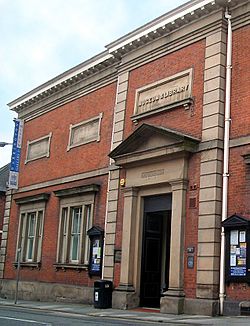
Warrington has a concert hall (the Parr Hall), an arts center (the Pyramid), and three museums. It also has many public libraries. Warrington Central Library was the first library in the UK to be supported by local taxes.
There are cinemas in Westbrook and the town center. Warrington has several parks and nature reserves like Woolston Eyes and Risley Moss.
Museums
Warrington Museum & Art Gallery is in Warrington's Cultural Quarter. It's one of the oldest public museums in the UK. The town also has the Museum of Policing in Cheshire and the Warrington Museum of Freemasonry.
Events
Warrington hosts many festivals and parades each year. Warrington Walking Day, which started as a Sunday school event, happens on the Friday closest to the end of June. The town center closes as churches walk through the streets together.
Other festivals include:
- Appleton Thorn Bawming of the Thorn
- Birchwood Carnival and Safari Day
- Croft Carnival
- Culcheth Community Day
- Glazebury Gala
- Howley Carnival
- Lymm May Queen
- Lymm Dickensian Festival
- Lymm Rushbearing
- Penketh Carnival
- Stockton Heath Arts Festival
- Thelwall Rose Queen
- Warrington Music Festival
- Winwick Carnival
- Westy Carnival
Music Scene
Free classical music concerts are held at Bold Street Methodist Church. Warrington also has many music groups, like the Warrington Male Voice Choir.
The Parr Hall is a special concert hall in Warrington. It has a famous pipe-organ made by the French builder Aristide Cavaillé-Coll.
Many rock and pop musicians are from Warrington. Ian Brown, the lead singer of The Stone Roses, was born here. Other artists include Spike Dawbarn from 911, Kerry Katona from Atomic Kitten, and members of Starsailor. The band Viola Beach was also formed in Warrington.
The TV show The Hit Man and Her often filmed at the Mr Smiths nightclub in Warrington in the late 1980s and early 1990s.
Warrington is home to the Neighbourhood Weekender music festival. This event takes place in Victoria Park in May. It started in 2018 and attracts over 50,000 people.
Parks and Open Spaces
Warrington has many parks, trails, nature reserves, and gardens. These places are great for outdoor activities. Many are dog-friendly and free to enter. Some popular spots include:
- Culcheth Linear Park: Open 24 hours with toilets and parking.
- Lymm Dam: Open 24 hours, with water features, wildlife, and woodland walks. You can also go fishing here.
- New Cut Heritage and Ecology Trail: A project with walking paths and links to other parks.
- Risley Moss Local Nature Reserve: Works with schools and helps local wildlife. It has parking and toilets.
- Sankey Valley Park: Open 24 hours, with picnic areas, parking, fishing, and play areas.
- Trans Pennine Trail: Open 24 hours, great for cycling, walking, and running.
- Victoria Park: Has sports facilities, training pitches, and is home to the Neighbourhood Weekender music festival.
- Walton Gardens: Features gardens, Walton Hall, a petting zoo, play areas, and mini golf.
Other parks include Woolston Park, Birchwood Forest Park, and Bank Park.
Historic Buildings
Warrington's historic center has many important buildings. These include Warrington Town Hall, St Elphin's Church, and Warrington Museum.
Churches and Other Religious Buildings
- St Wilfrid's Church, Grappenhall: A medieval church built in the 1300s.
- St Oswald's Church, Winwick: Another medieval church.
- Parish Church of St Elphin: Mostly rebuilt in the Victorian era, it has a tall spire.
- Holy Trinity Church: A Georgian church from 1758.
- St Mary's Church: Designed by E.W. Pugin and Peter Paul Pugin.
Town Landmarks
- Warrington Museum & Art Gallery: One of the oldest public museums in the UK.
- Warrington Town Hall: A grand building with famous golden gates.
- Halliwell Jones Stadium: Home to the Warrington Wolves rugby team.
- Parr Hall Concert Hall: Has a rare and famous pipe-organ.
- Pyramid Arts Centre: A place for arts and culture.
Industrial and Commercial Landmarks
- Warrington Transporter Bridge: A historic bridge that moves to let ships pass.
- The Barley Mow: Established in 1561, it's the oldest pub in Warrington.
- The row of Victorian shops on Bridge Street.
- Fiddlers Ferry Power Station: A large power station that is now closed.
- The Unilever Soapworks: A modern industrial building.
- IKEA store: The first IKEA store built in the UK.
Other Landmarks
- Grappenhall Heys Walled Garden: A beautiful historic garden.
- The Warrington Academy: A historic school where Joseph Priestley once taught. A statue of Oliver Cromwell stands in front of it.
- "Cromwell's Cottage": A 17th-century building said to have been visited by Oliver Cromwell.
Education in Warrington
Higher Education
The University of Chester has a campus in Padgate.
Colleges
Warrington has three colleges: Priestley Sixth Form and Community College, Warrington and Vale Royal College, and University Technical College Warrington. Many high schools also have their own sixth forms for older students.
Schools
There are 14 high schools in the borough:
| Region | School name | Type of school | Headteacher/principal | Pupils |
|---|---|---|---|---|
| Birchwood | Birchwood Community High School | Academy Converter | Emma Mills | 1,124 |
| Culcheth | Culcheth High School | Community | Chris Hunt | 1,132 |
| Appleton | Bridgewater High School | Academy Converter | Kieron Powell | 1,650 |
| Latchford | Sir Thomas Boteler Church of England High School | Church of England (Aided) | Beverley Scott-Herron | 752 |
| Latchford | Cardinal Newman Catholic High School (Warrington) | Roman Catholic (Aided) | David Lewis | 780 |
| Great Sankey | Great Sankey High School | Academy Converter | John Shannon | 2,000 |
| Lymm | Lymm High School | Academy Converter | Gwyn Williams | 1,877 |
| Padgate | Padgate Academy | Academy Converter | Neil Harrison | 455 |
| Penketh | Penketh High School | Academy Converter | John Carlin | 1,137 |
| Westbrook | St Gregory's Catholic High School | Roman Catholic (Aided) | Edward McGlinchey | 988 |
| Orford | Beamont Collegiate Academy | Academy Converter | Gareth Harris | 750 |
| Padgate | King's Leadership Academy Warrington | Free School | Katie Sharp | 320 |
| Lymm | Bright Futures School | Private | Ruth Clifford | 30 |
| Thelwall | Chaigeley School | Private | Paul Lambert | 35 |
There are also 69 primary schools in the borough. The Manchester Japanese School holds its weekend classes at Lymm High School.
Sports in Warrington
Rugby league is the top sport in Warrington. The town's team is the Warrington Wolves. They are nicknamed "The Wire" because Warrington used to make a lot of wire. In 2003, the club moved to the Halliwell Jones Stadium. The Warrington Wolves are the only team to have played every season in the top rugby league division. They won the Challenge Cup in 2009, 2010, and 2012. They also won it again in 2019. They reached the Super League Grand Final several times but lost to Wigan Warriors.
Warrington also has several amateur rugby league teams:
- Bank Quay Bulls ARLFC
- Burtonwood Bulldogs ARLFC
- Crosfields ARLFC
- Culcheth Eagles ARLFC
- Latchford Albion ARLFC
- Rylands ARFLC
- Woolston Rovers ARLFC
Football is played by Warrington Town at Cantilever Park. They are nicknamed Town, Yellows, and The Wire. Warrington Town was promoted to National League North in 2023. Their biggest success was in the 2014 FA Cup, when they reached the first round for the first time. They famously beat Exeter City 1–0 in a game shown live on BBC One. The town also has another non-league team, Rylands F.C..
Rowing has been happening in Warrington for nearly 200 years. The modern Warrington rowing club started in the mid-1980s.
Warrington Athletic Club is at Victoria Park. A new running track was built there in 1998.
Speedway racing took place in Warrington between 1928 and 1930.
Warrington Wolves Basketball team started in 2009 and plays in the English Basketball League.
Warrington has four main rugby union teams: Warrington RUFC, Lymm RFC, Gentlemen of Moore RUFC, and Eagle RUFC.
News and Media
Warrington gets its TV signals from the Winter Hill TV transmitter.
Local radio stations include BBC Radio Manchester, BBC Radio Merseyside, Heart North West, Capital North West & Wales, and Greatest Hits Radio Liverpool & The North West (formerly Wire FM). Community radio station Radio Warrington broadcasts online and plans to have an AM signal.
Warrington's oldest newspaper is the Warrington Guardian. It's published weekly and is owned by Newsquest. Warrington Worldwide is a free monthly news magazine, and it also has a daily news website. The free monthly newspaper Cheshire Times is also given out in the southern part of the borough.
Famous People from Warrington
Up to 1700
- James Bell (1524–1584): A Catholic priest.
- Thomas Dallam (c1570 – 1614): An organ builder and trade envoy.
- Edward Barlow (1639–1719): A priest and inventor.
- John Harrison (1693–1776): Inventor of the marine clock.
- Susanna Wright (1697–1784): An American poet and botanist.
- Hamlet Winstanley (1698–1756): A painter and engraver.
1700 to 1800
- John Macgowan (1726–1780): A preacher and satirist.
- Anna Blackburne (1726–1793): A naturalist who wrote to Carl Linnaeus.
- Edward Evanson (1731–1805): A clergyman.
- Joseph Priestley (1733–1804): A scientist who discovered oxygen. He taught at the Warrington Academy.
- Thomas Percival (1740–1804): A doctor who created the first modern rules for medical ethics.
- Anna Laetitia Barbauld (1743–1825): A poet and literary critic.
- Peter Litherland (1756–1805): A watchmaker and inventor.
- Elizabeth Whitlock (1761–1836): An actress.
- Colonel John Drinkwater Bethune (1762–1844): An army officer and historian.
- John Cragg (1767–1854): An iron manufacturer.
- Arthur Aikin (1773–1854): A chemist and writer.
- Charles Rochemont Aikin (1775–1847): A doctor and chemist.
- Edmund Aikin (1780–1820): An architect.
- Lucy Aikin (1781–1864): A historical writer.
- Maria Hill (1791–1881): A Canadian hero.
- Joseph Crosfield (1792–1844): Started a soap and chemical business.
- William Beamont (1797–1889): A lawyer and helper of the community. He founded churches and the library.
- William Wilson (1799–1871): A botanist.
1800 to 1900
- William John Beamont (1828–1868): A clergyman and author.
- James Charles (1851–1906): An impressionist artist.
- Sir Luke Fildes (1843–1927): An artist.
- Sir Gilbert Greenall, 1st Baronet (1806–1894): A businessman and politician.
- William Kirtley (1840–1919): A railway engineer.
- Joseph Leicester (1825–1903): A glass blower and politician.
- Jeannie Mole (1841–1912): A socialist and trade union organizer.
- William Norman (1832–1896): A local war hero who received the Victoria Cross.
- William Owen (1846–1910): An architect.
- B. H. Roberts (1857–1933): A Mormon leader and historian.
- Peter Rylands (1820–1887): A wire manufacturer and politician.
- Captain Guy Wareing (1899–1918): A World War I flying ace.
- John Webster (1845–1914): A civil engineer who designed bridges.
- Henry Woods (1846–1921): A painter.
1900 to 1950
- George Formby (1904–1961): A famous entertainer.
- Ernest Whitty (1907–1985): A footballer.
- George Cardell Briggs (1910–2004): The first Bishop of The Seychelles.
- Petty Officer Alfred Edward Sephton (1911–1941): Received the Victoria Cross.
- Gordon Ellis (1920–1978): A painter.
- Burt Kwouk (1930–2016): An actor, known for The Pink Panther films.
- Eric Tucker (1932–2018): An artist.
- Geoffrey Hewitt (1934–2019): A chemical engineer.
- Dave Cook (1941–1993): A communist activist and rock climber.
- Ossie Clark (1942–1996): A fashion designer.
- Sue Johnston (born 1943): An actress, known for Brookside and The Royle Family.
- Ann Pilling (born 1944): An author and poet.
- Pete Postlethwaite (1946–2011): A famous actor.
- Peter Brimelow (born 1947): An American writer.
- Paul Lewis (born 1948): A financial journalist and radio presenter.
- David Banks (born 1948): A former British newspaper editor.
1950 to Today
- Pete McCarthy (1951–2004): An actor.
- Steve Parker (born 1952): A writer of science books.
- Martin Sixsmith (born 1954): An author and TV presenter. His book Philomena was made into a film.
- Joan Ryan (born 1955): A politician.
- George Davey Smith (born 1959): An epidemiologist.
- Helen Newlove, Baroness Newlove (born 1961): A community campaigner.
- Gary Slater (born 1961): A sports journalist.
- Martin Roberts (born 1963): A TV presenter.
- Robin Jarvis (born 1963): A children's novelist.
- Andy Bird (born c. 1964): A film producer and executive.
- Tim Firth (born 1964): A writer and songwriter.
- Polly Walker (born 1966): An actress, known for Rome and Bridgerton.
- Gavin Patterson (born 1967): A business executive.
- Rebekah Brooks (born 1968): A journalist and newspaper editor.
- Chris Matheson (born 1968): A Labour Party politician.
- Liam Byrne (born 1970): A Labour Party politician.
- Curtis Jobling (born 1972): An author, illustrator, and animator (Bob the Builder).
- Helen Wilson (born 1973): A mathematician.
- Steven Arnold (born 1974): An actor, known for Coronation Street.
- Helen Walsh (born 1977): A writer and film director.
- Warren Brown (born 1978): An actor.
- Nathan Head (born 1980): An actor in horror films.
- Darren Jeffries (born 1982): An actor, known for Hollyoaks.
- George Sampson (born 1993): A dancer and winner of Britain's Got Talent.
- Alfie Devine (born 2004): A footballer for Tottenham Hotspur.
- Luke Littler (born 2007): A professional darts player.
- Jarell Quansah (born 2003): Plays for Liverpool FC.
Musicians
- Edwin 'Ted' Astley (1922–1998): A composer.
- Edna Savage (1936–2000): A pop singer.
- Tim Curry (born 1946): An actor, singer, and composer.
- Pete Waterman (born 1947): A record producer.
- John Maines (born 1948): A musician and trombone player.
- Gareth Jones (born 1954): A music producer.
- Miles Tredinnick (born 1955): A rock musician and songwriter.
- Phil Kelsall (born 1956): The main organist at the Blackpool Tower Ballroom.
- Stephen Hough (born 1961): An international concert pianist.
- Tim Bowness (born 1963): A singer-songwriter.
- Ian Brown (born 1963): Lead singer of The Stone Roses.
- Chris Evans (born 1966): A DJ and TV presenter.
- Anthony Whittaker (born 1968): A composer and pianist.
- Jan Linton (born c. 1968): A singer-songwriter.
- Chris Braide (born 1973): A songwriter and record producer.
- Dave Vitty (Comedy Dave) (born 1974): A DJ.
- Kerry Katona (born 1980): A singer and TV personality.
- Bill Ryder-Jones (born 1983): Former guitarist of The Coral.
- Viola Beach (formed in 2013): A band from Warrington.
- James Smith (born 1990): Lead singer of Yard Act.
Sports People
- Steve Donoghue (1884–1945): A famous jockey.
- George Duckworth (1901–1966): A cricketer who played for England.
- Fred Worrall (1910–1979): A footballer.
- Harold 'Moggy' Palin (1916–1990): A rugby league player.
- Roger Hunt (1938-2021): A footballer for Liverpool FC and part of England's 1966 World Cup team.
- Neil McGrath (born 1942): A former racing driver.
- Bob Fulton (1947–2021): An Australian Rugby League player.
- Keith Elwell (born 1950): A rugby league player.
- Wade Dooley (born 1957): A former England rugby union player.
- Gary Bannister (born 1960): A former professional footballer.
- Hugh de Prez (1951–2008): A cricketer.
- Neil Fairbrother (born 1963): A cricketer who played for England.
- Tony Ward (born 1970): A former professional footballer.
- Tony Bullock (born 1972): A former professional goalkeeper.
- Stephen Foster (born 1980): A footballer.
- David Wright (born 1980): A former professional footballer.
- Ian Sharps (born 1980): A former footballer and coach.
- Paul Hanagan (born 1980): A champion jockey.
- Matt Doughty (born 1981): A former professional footballer.
- Jonathan Akinyemi (born 1988): An Olympic Canoe Slalom athlete.
- James Chester (born 1989): A footballer.
- Jesse Lingard (born 1992): A footballer.
- Jack Robinson (born 1993): A professional footballer.
- Stan Woodhouse (1899–1977): A professional footballer.
Warrington's Twin Towns
Warrington is twinned with these towns:
 Hilden, Germany
Hilden, Germany Náchod, Czech Republic
Náchod, Czech Republic Česká Skalice, Czech Republic
Česká Skalice, Czech Republic Červený Kostelec, Czech Republic
Červený Kostelec, Czech Republic Hronov, Czech Republic
Hronov, Czech Republic Jaroměř, Czech Republic
Jaroměř, Czech Republic Nové Město nad Metují, Czech Republic
Nové Město nad Metují, Czech Republic
The villages of Lymm and Culcheth in the borough are twinned with these French towns:
Freedom of the Borough
Some people and military groups have been given the special "Freedom of the Borough" award in Warrington.
Individuals
- Lord Hoyle, November 2005
- Roger Hunt, December 2016
Military Units
- The South Lancashire Regiment, September 1947
- The Queen's Lancashire Regiment, March 1970
- The Duke of Lancaster's Regiment, 2006
- 75 Engineer Regiment, 2013
See also
 In Spanish: Warrington para niños
In Spanish: Warrington para niños





